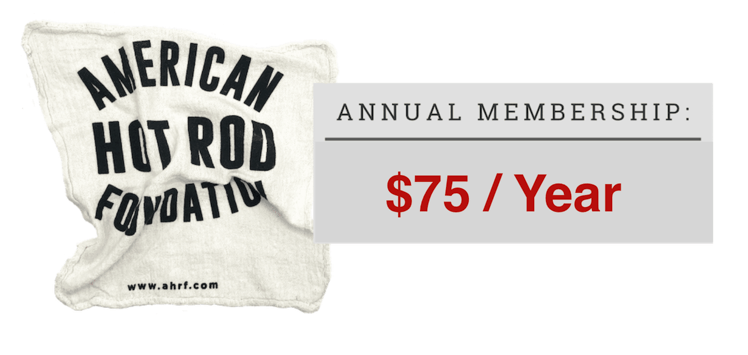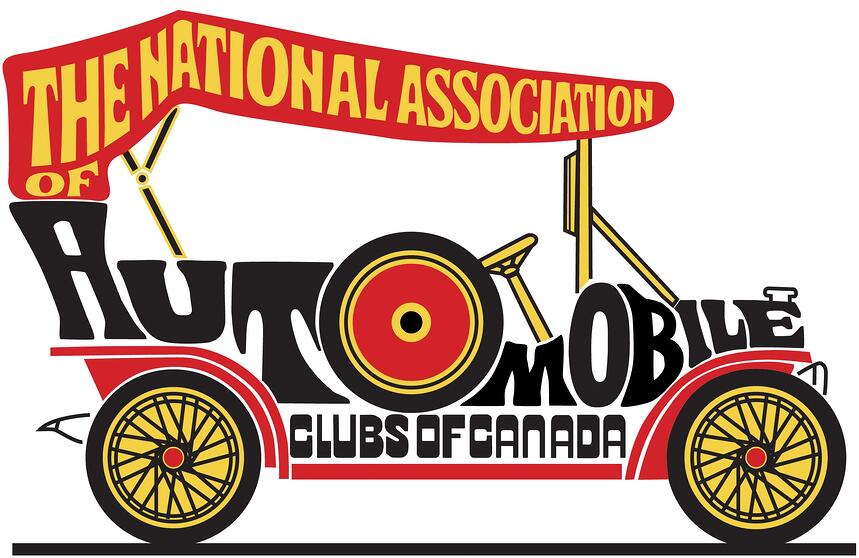You never know what will happen or whom you’ll meet when you go to the dry lakes. The more time you spend there the more you know, but the less you know and you should always consider yourself a newbie. It is a humbling place.
I don’t care if you’ve been there five years or fifty, somebody’s always been there longer. Julian DuVall Doty is a fine example.
As a youngster in the roaring 20s, Julian would ride with his Dad in a Model-T on his work route taking them to San Fernando, Newhall, Piru, Filmore, Santa Paula, Santa Barbara, Ventura, Oxnard then back to the Valley, then home. Later, in the 20s and 30s, his dad was in charge of transportation for production companies that specialized in Westerns for RKO, Paramount, and MGM. It was around this time that Julian’s Dad and some buddies started running a Rajo-T at Ascot. Julian tagged along when they worked on the car, usually getting in the way and dirty from head to toe. They would set him up in the driver’s seat, and you can just bet he always had a fantasy finish a cars length in front of his hero, Frank Lockhart. Julian later raced about in his own soapbox car in Whitley Heights above Hollywood Boulevard, living out his speed dreams.
In The Early 30s, Julian spent weekends at Grandmas with uncle George DuVall, who became famous for his roadster windshields. They would cruise around in his Cragar powered 29 A roadster tricked out with fender skirts. In 34, Julian and uncle George made their first trip to Muroc together. Julian continued to go with an assortment of friends until 1938 when he acquired a motorcycle and could take himself. Julian rode that motorbike until 1959.
Julian bought his first car off Jack Bartz’s used car lot at La Brea and Santa Monica with money earned from odd jobs and Pop bottles. It was a 29 Model A roadster with an Olds 3-port mill in it. Since he was only 14, his dad drove it home for him. After many hours of tinkering and at least 20 miles of back and forth in the driveway, Julian finally worked up the nerve for an excursion on his dead-end street. To gain some real mechanical experience, the budding car nut took an apprenticeship at R. J. Dawson on Las Palmas overhauling Hudsons and Ford engines while still in junior high school.
In his spare time, the adventurous Julian pulled the 3-port from his 29 and then bought a Miller-Schoefeld for $120 from Curley Grandall, who had raced it at Ascot. His payments were $5 per week. He next ran it at the lakes but it was not fast enough, so in 1940 Julian built up a 31 model A roadster and bettered 101MPH at Muroc. He ran the car on the street till 72 and put 90,000 miles on it. The motor is still collecting dust today in one of his sheds.
Behind the Seaside Gas station at Santa Monica and Spalding was the original B & S (Boy Scout Super-Service to the ladies of the neighborhood, Baldwin & Sommerfeld, Doty to the car guys) Garage. This is where Julian, Baldie, Gus and Mal Ord built the Danny Sakai Modified, probably one of the most famous pre-war lakes cars. Next door was The Hollywood Throttlers Clubhouse, along with the garages of Leonard Folkerson, Danny Sakai and Pat Campi. B & S later moved to Genesee Street in 1946 operating until 1976.
With a lull in lakes racing, and a need for some extra money Julian, Bob Bliss and Bob Corbet pooled their resources and bought a 37 Ford dump truck. They moved to San Louis Obispo and rebuilt the airport. Julian took his lakes roadster with the button flywheel and his cycle with him as transport. Just think of the fun he had hand cranking that A on a cold morning with an updraft Winfield. In need of more toys, Julian bought a 33 model Hudson-Terraplane straight-8 for $180. It hadn’t run in a few years, but he got it purring in no time. Something wasn’t right with the body as the paint wouldn’t stick. After some investigation, it was found to be a special aluminum bodied car that just happened to have been a Daytona Beach winner. With the bombing at Pearl Harbor, Julian went back to L.A. with his toys, mothballed them and went off to war. It was in February 42.
While he was gone, Julian’s younger brother Ray needed a ride to the beach. What better way to do it than in a Terraplane. Ray and his buddies took the car off blocks, tuned it up and sped off. Disaster struck at Santa Monica and La Cienega because the boys had neglected to tighten the lug nuts and lost 2 wheels, ditching the car on the trolley tracks. They called a tow-truck, its wartime with scrap drives, exit one aluminum bodied car to the cause for $25. The boys got weekend cash, but Julian lost a car that would be worth $300,000 today. Julian worked off and on with Harry A. Pelton Motorcycles from 1936 to 1947. They went Class A short track racing with a stable of 13 J.A.P.s and a Crocker. They ran many tracks including Lincoln, Atlantic, Carroll and Culver City. When they took their traveling road show to Portland Oregon for three months, the boys lived on Burgers and Cokes for .20 cents at a local bowling alley. Ah, the joys of road trips.
I hope to have a car running next year. Probably be a straight 8 in an A chassis. I was sure glad to see some of the old boys getting out and hope to soon myself. Tell everyone good speeds and safe driving at the lakes.
Excerpt from a letter SGT. J. Doty wrote to the S.C.T.A. News from Germany in 1945, published in Vol. II, No. 14.
After being discharged from military service it was back to the S.C.T.A. Julian worked will Mel Leighton as treasurer and was on the Hospital Committee for almost 6 years. He and Sidewinder President Kong Jackson were starters in 47-48. Meets averaged more than 200 entries per event and getting cars off the line at regular intervals was a real problem. In the best hot rod tradition, Julian and Kong stole some traffic signals, set them up and voila! more efficient starting. At the end of 47, the Milers were re-formed and Julian was a charter member with other future Sidewinders, Harold Johansen and Don Waite. That was more than 50 years ago, and Julian still has his original embroidered coverall and the pattern for the club plaque.
In 1948 Julian and Charley Fry went back to The Speedway (Indianapolis) in a 29 A roadster with a 3/8 x 3/8 flattie and 7.50×16 on the rear, to help crew on some serious race cars. They worked on the Tommy Lee Cars, the mighty pre-war Mercedes-Benz with Chet Miller driving and a KK2000 Offy.
They couldn’t get the Mercedes qualified, but Mack Hellings finished a credible 5th with the Kurtis. They also helped Ed Winfield and crew chief Jean Marceinac with the mighty Novi Cars driven by Ralph Hepburn and Duke Naylon. Unfortunately, Hepburn crashed to his death, but Nalon earned the best ever finishing position for a Novi in 3rd. On the way back the boys swung through Michigan. While stopped at a diner in the Detroit area, they were approached by two men in dark suits and hats asking about the hot-rod.
Next thing you know the boys are in a FoMoCo dyno room staring wide-eyed at the soon to be released flathead 6. Not bad for a two-month vacation.
Between lakes meets you could find Julian at one of Southern California’s 15 race tracks like Gilmore Stadium, working behind the wheel of the famous Frank Kurtis built, DuVall wind shielded Southern California Plating Company 36 Ford phaeton pull/push truck. Few people can say they pushed around Billy Vukovich or Sam Hanks. Doty Did. In the late 40’s at Uncle George’s Pacific Metal Products Julian performed machine work on hot rod intake manifolds for Eddie Meyer, Tattersfield, Edmonds, etc. He was also responsible for the bright work on Mad Man Muntz’s Jet. At the First Annual S.C.T.A. Hot Rod Expo in 1948, Julian towed most of the cars into the armory with his straight-8 powered Model T roadster pickup sporting a Dodge tubular front axle and a Franklin rear end.
One of Doty’s better adventures was his first trip to Bonneville in 49. Kay Kimes, Dave Ratliff, and Julian got a hold of an old Ascot sprint car. They gathered up parts, here and there, and built up a flattie motor. With a 4:11 ring and pinion, gearing was going to be a problem, so with a little machine work and ingenuity they flipped the cluster gear in the tranny so first gear was direct, 2nd gear was higher and 3rd gear was sky high. They loaded up the 39 Dodge pickup with gas, water, tools, and sleeping bags and took off, flat-towing at 35 mph. By Red Rock Canyon the truck was overheating. They stopped and unhooked the race car started it up–, any excuse to break in a fresh motor. Dave drove the first stint to Alanchia, and then Julian took the wheel. When they
arrived at small towns they would kill the engine and push it through. At Miller’s corner, Julian ran out of gas. A short time later, sitting on the rear wheel in the blistering sun, a couple in a 48 Buick Convertible came along and rescued our hero by pushing him 13 miles into Tonapah. Two hours later, Kay and Dave show up believing Julian had run off the road. Kays drove after that. With three hours of break-in time and only six runs on the salt, they turned a respectable 141 mph before the tranny went south.
In 50 he was back at the salt with the B & S (Baldwin, Summerfield, and Doty) 27 T track roadster powered by a Riley 4-port. They lost a flywheel that chewed up the frame. This was the same roadster and crew that campaigned in earlier CRA events with Louie Falkner, Puffie Puffer, Mac Hellings, and 16-year-old Troy Rittman as drivers. The B & S team was also a constant winner at the Saugus drags from ’49-’52 with a McDowell powered sprint car, winning 40 out of 41 stars. In 53 as the C & D entry at Bonneville, the sprinter turned 140.
Between the years 51-58 saw the yellow then orange B & S wing-tank lakester run with the 4-port run at the lakes and salt. The high points to those years were winning the S.C.T.A. Points Championship in 1956 and 1958. The car later ran with a 4-banger Tempest with a special D.O.H.C. 4-valve head that has its own story. At Julian’s urging the head was designed on paper napkins between libations at Edwards Steak House on 7th and Alvarado by old friends Leo Goosen, Offy God, and Arnold Birner, prewar lakes racer and pattern-maker extraordinary. Only five 220 Offy-nee-Tempest heads were cast. At the May 1960 meet the car ran 150.75. In 61 the car set the F/L records at 165.13 and held it till 64. The car eventually ran 221 and Julian still has the car and mill today.
In the mid-’60s, one of Doty’s many friends found some Hispano-Suiza motors from the WWI era, and another adventure was hatched. They gathered up plans and scratch-built three SE5-A replica aircraft. One now rests in the Air Force Museum. Julian then found to build another tank with friends Jerry Silverstein and Arnold Birner. This time with front-wheel drive, the Tempest powered beast with a Stage-4 head ran 226. The ’70s were a busy time for Julian, becoming a representative for the Sidewinders at board meetings, he did that for five or six years and starting in 72, he’s been the man with the big smile who makes and gives out official timing slips at the lake meets. Long-time lakes racer and past S.C.T.A. President Mike Cook thinks that if your time slip doesn’t have Julian’s autograph on it, it’s not worth anything. Back at B&S, his specialty was rebuilding VWs for hippies like Charlie Dole, of Pineapple fame.
For a man who received the illustrious Wheels of Fame award from the S.C.T.A., there was always 40 irons in the fire, like building a new tank or dusting off the old Riley 4-Port and he even made a pass at El Mirage in Roy Creel’s 4-banger roadster at the spry age of 79. When asked about the most important lesson he has learned over the 70 plus years of being a lakes denizen, he replied,
On the salt, always wear plenty of suntan lotion, especially when wearing shorts and no skivvies! You don’t want to get sunburned private parts, it hurts.
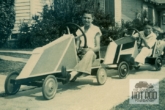
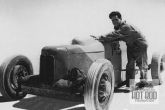
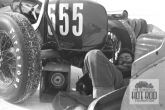
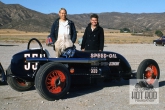
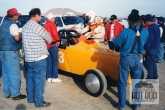
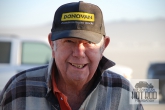
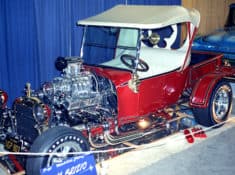 Andy Brizio
Andy Brizio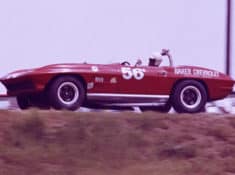 Dick Guldstrand
Dick Guldstrand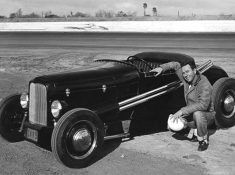 Jack Calori
Jack Calori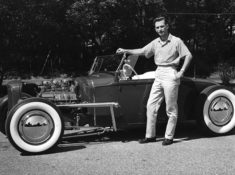 Bill Neumann
Bill Neumann